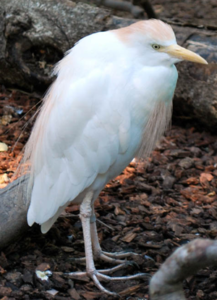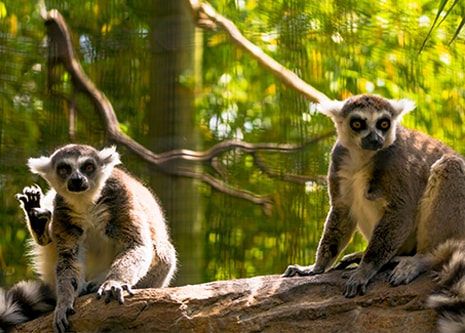
- VisitSupport Happy HollowDONATE TODAYExploreSupport Happy HollowDONATE TODAYLearnSupport Happy HollowDONATE TODAYSupport
-
Today's Hours: 10:00 am to 5:00 pm
Zoo in the HollowCattle egret

Scientific name: Bubulcus ibis
Family: Ardeidae
Order: Pelecaniformes
Class: Aves
Range: Worldwide
Habitat: Grassland, urban, wetland
Lifespan: Unknown in the wild; up to 20 years in captivityWhat do they look like?
Cattle egrets are white heron-like birds, 18 to 22 inches long with a 32 to 38 inch wingspan. They have long legs and toes, a thick neck, and a long, sharp bill, which is black in juveniles and yellow in adults. When flying or resting, they curve their neck into an S-shape, which gives them a hunched-over appearance. How do they behave? Unlike other egret species, cattle egrets do not exclusively inhabit wetlands. This species has a commensal relationship (an animal benefits while their host animal is not affected) with large grazing herbivores. Cattle egrets will eat the insects and small animals that are stirred up by these large grazers, and they can be seen following alongside or riding on the backs of their hosts. This allows these birds to live in a variety of habitats wherever their hosts are found. Cattle egrets can use any animal or machine that stirs insects up out of the ground as a commensal host. Animal hosts can include cattle, water buffalo, ostriches, and even rhinoceroses. Machine hosts can be anything from tractors to lawn mowers, and even airplanes! These egrets prefer to follow slower moving hosts, allowing them to keep up with the herd on foot while foraging.What do they eat?
Cattle egrets predominantly eat insects, but they may also eat other small creatures that are disrupted by the movement of their hosts, such as frogs, snakes, worms and eggs. At Happy Hollow, they eat mice, specialized bird food and insects.How are they born?
During their summer breeding season, both males and females grow orange breeding plumage. Breeding plumage is longer and darker in males. Cattle egrets nest in colonies, where they find a new mate every mating season. It is in these colonies that the males perform elaborate courtship rituals that consist of raising their breeding plumage, swaying and flying with exaggerated wingbeats. Pairs build a nest together, and the female lays three to four eggs, which both parents incubate for about 25 days. Once hatched, the nestlings will be fed via regurgitation by both parents until they become independent after six weeks.Conservation
Cattle egrets are so widespread and successful that they are classified as a species of Least Concern by the International Union for Conservation of Nature . Human development worldwide has had a positive effect overall for this species, but has also increased the likelihood of pollution ending up in cattle egret habitat. The North American Breeding Bird Survey was created to monitor the status of bird populations, which provides data used by the U.S. Fish and Wildlife Service to determine the conservation status of this species and others. If you would like to support the cattle egret’s success in the wild, you should dispose of all household chemicals properly to prevent them from entering cattle egret habitat, which could result in harmful build up in a cattle egret’s feathers. Keeping our water clean is good for both cattle egrets and people.
Zoo on the Hill
Located across from the Keep-Around Carousel is the Zoo on the Hill. Learn about wildlife up close during daily meet-and-greets, leap like a lemur on the playground, brush and feed the goats,, or take a peek inside Doc’s Critter Care building and the Ranch House. Double-H Ranch features a combination of animal exhibits, including giant anteaters and red ruffed lemurs, as well chickens and domesticated animals that are docile enough to touch.
See Animals
Education Ambassadors
From camps and classes to scout badges and sleepovers, Happy Hollow education programs have something for everyone! The zoo education program offers a broad range of hands-on, engaging programs and public presentations featuring education ambassador animals. These encounters are designed to connect you to wildlife and the conservation of their habitats around the world.
See AnimalsVisit Us Today
Plan an unforgettable experience at San Jose’s family-friendly park and zoo.
Learn More